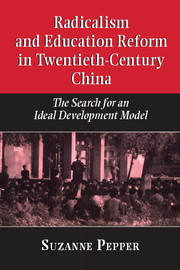Book contents
- Frontmatter
- Contents
- Acknowledgments
- 1 Educational development and the Chinese experience
- Part I The republican era: origins of radical education reform
- Part II Learning from the Soviet Union
- Part III Cultural revolution and radical education reform
- Appendix: the Hong Kong interviews
- Select bibliography
- Index
1 - Educational development and the Chinese experience
Published online by Cambridge University Press: 04 August 2010
- Frontmatter
- Contents
- Acknowledgments
- 1 Educational development and the Chinese experience
- Part I The republican era: origins of radical education reform
- Part II Learning from the Soviet Union
- Part III Cultural revolution and radical education reform
- Appendix: the Hong Kong interviews
- Select bibliography
- Index
Summary
By the mid-1970s, China's experience was being heralded within the international development community as a new model worthy of praise and emulation. Leftist radicalism inspired by events in China and elsewhere during the 1960s was already beginning to fade. But as China opened its doors to the outside world after the chaotic inaugural years (1966–1968) of the Cultural Revolution, political pilgrims were followed by a growing assortment of development professionals, academics, and others. They usually arrived asking what might be learned from the Chinese experience and left in general agreement that, while revolution might be a heavy price to pay, its achievements deserved to be acknowledged as such. Educational development ranked high on the list of benefits.
Admiration grew so great that China was soon being hailed as an example, virtually unique among low-income countries, in following the spirit of the World Bank's 1974 education sector recommendations – even though China was at that time still beyond the pale of the bank's lending and advisory operations. Economist John Simmons reiterated the new consensus when he wrote at the end of the decade that China's education system “comes closest to the World Bank's model program for a developing country.” The essential features of the Chinese system in this respect were a curriculum designed to meet the needs of a mass clientele; the widely promoted goal of 10-year universal schooling; decentralized local administration; and tertiary-level selection aimed at minimizing discrimination against the poor. These achievements were, moreover, being sustained at low cost within an economy where per capita yearly income was estimated at only U.S.$2SO. This placed China within the lowest-income category, where levels of educational development were generally least impressive.
- Type
- Chapter
- Information
- Radicalism and Education Reform in 20th-Century ChinaThe Search for an Ideal Development Model, pp. 1 - 34Publisher: Cambridge University PressPrint publication year: 1996



